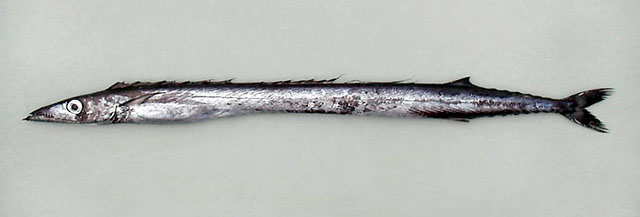| Gempylidae (Snake mackerels) |
| 100 cm SL (male/unsexed) |
|
pelagic-oceanic; marine; depth range 0 - 600 m, oceanodromous |
| Worldwide in tropical and subtropical seas. Adults also often caught in temperate waters. Specimen caught on the Atlantic side of South Africa (33°08'S 16°47'E at 700 m) (Ref. 6193) probably strayed from the Indian Ocean. |
|
Dorsal spines (total): 27-33; Dorsal soft rays (total): 10-14; Anal spines: 3-3; Anal soft rays: 10-12; Vertebrae: 48-55. Body is elongated and strongly compressed. The mouth is large with fang-like teeth. There are two lateral lines, both originating below the first spine of the dorsal fin. The upper lateral line follows the dorsal contour of the body to the end of the first dorsal fin base. The lower descends gradually posterior to about the tip of the pectoral fin and runs mid-laterally. Body color is uniformly dark brown; all fins dark brown with somewhat darker margins. |
| Strictly oceanic and usually solitary (Ref. 6181). Adults migrate to the surface at night while larvae and juveniles are found near the surface during the day (Ref. 6181). Feed on fishes, cephalopods and crustaceans (Ref. 9302). Males mature at 43 cm SL, females at 50 cm (Ref. 36731). Eggs and larvae are pelagic (Ref. 6766). Sold frozen, as sausages or fish cake (Ref. 9302). Not eaten raw, but cooked in any way, also dried (Ref. 7364). |
|
Least Concern (LC); Date assessed: 23 August 2012 Ref. (130435)
|
| harmless |
Source and more info: www.fishbase.org. For personal, classroom, and other internal use only. Not for publication.

